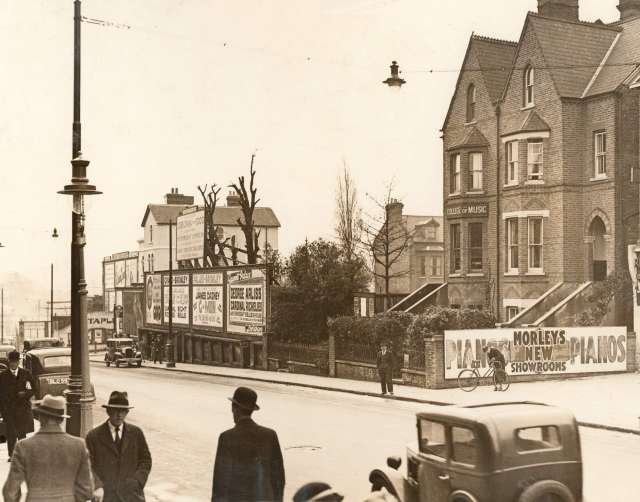- Home
- Local History
- To Be Or Not To Be: A History of Bromley’s Theatres
To Be or Not To Be: A History to Bromley's Theatres
Written by Pam Preedy.
I remember my parents were keen theatre-goers. There was a special deal in the 1950s at Bromley’s New Theatre: two seats for the price of one, on Mondays. Who doesn’t like a bargain?
At the time we had no knowledge of the vicissitudes of the theatre’s life or the various names it had been given: the Grand Hall (from 1889), the Lyric (from 1905), the New Theatre (from 1948 and the Churchill (opened on 19th July 1977).
In 1889 the Grand Hall and Country Club opened with a pantomime. It was built on a site behind two shops; numbers 22 and 23 High Street (Now Lidl’s), built partly over a former duck pond. The auditorium contained a large swimming pool, intended to be boarded over for dances and theatricals, and above the stage was a tank capable of holding 1,999+ gallons of water. At first the pool was used by school children in 1891 for 1, 1/2d. a week, but in 1891 it developed a leak and was permanently closed.

There were some early successes with such offerings as the lecture by Dr. Barnado about rescuing waifs and strays (1890) and performances of The Mikado and The Gondoliers by the D’Oyley Carte Opera Company (1891), but there was always the problem of getting licences to put on performances.
Censorship was introduced by Henry VIII (1553) to theatres to prevent the stage from being used for religious propaganda. Other restrictions followed: Oliver Cromwell (1653-1658) banned all plays to prevent public disorder; Prime Minister Sir Robert Walpole (1737) tightened up the censorship of drama to prevent political satire against him, stating that the Lord Chamberlain with his Examiners of Plays must vet any script before a performance. The theatre in Bromley was subject to the theatre licencing laws which controlled what could be performed and how often.
In the 30 years after opening the Grand Hall underwent a number of changes; from a full refurbishment which included the repair of the roof, fireproof curtain, adjustment of the counterweights and a permanent floor over the pool supported by steel girders and started a new life as the Lyric Theatre on 4th February 1899. The manager continued to produce dramas such as Hamlet, School for Scandal and David Garrick (1905) but they were poorly attended. Other highlights were variety shows and lectures. From 1907 ‘silent movies’ gained popularity. They came to Bromley to the Grand Hall, now billed as ‘The Premier Picture Theatre’, accompanied by a huge orchestra.

When ‘talkies’ came to England in the twenties, the theatre was taken over by the Provincial Cinematograph Theatres (PCT) chain and in 1934 came under the control of the Gaumont British Theatres chain. The operated the Grand Theatre as a cine-variety house until they closed it in May 1937, once their massive 2,498 seat Gaumont super cinema opened (now the home of ‘Dreams’). The Grand still produced some live shows and was converted into a strictly live theatre venue, but in 1940, it was requisitioned by the Government to become food stores for the duration of World War II.
After the war, the building was de-requisitioned, re=opening on 26th December 1947 as the New Theatre and was served by a repertory company. This meant that while one group performed another group was rehearsing – they had to be word-perfect. The system gave opportunities to new actors, such as David Jason, where they could learn their craft.
On 6th May 1971 The New Theatre was destroyed by fire. The remains were later demolished. In 1977, out of the ashes, like a phoenix, on a site adjacent to the old theatre, the Churchill Theatre and Library rose, at a cost of about £4,431,000, though with the sale of the shops and grants from the Arts Council and other sources of finance, the final cost to the ratepayer was about £1,630,000.

Cliff Richard (May 1971), standing in the rubble of the burnt out building where he was supposed to perform in the play ‘The Potting Shed’ by Graham Green. Photo Credit: Harry Dempster (Getty Images)

Originally published in Life in Bromley magazine (Issue 21, November 2023)
Further Reading:
I would highly recommend ‘The Theatres of Bromley’ by Sheila Dunn. It’s a delightful book which intertwines the history of our theatre with the details of life in Bromley at the time.
